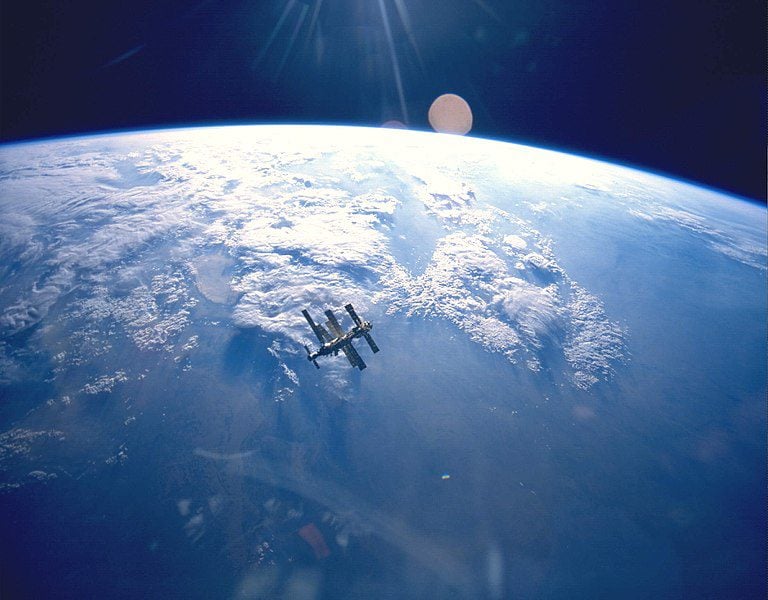
(NASA public domain photo)
Mir’s orbital altitude averaged about 223 miles above Earth’s surface.
***
From the Best-Laid Plans Department: I gave a lecture last night up at the Jordan Events Center on the life of the Reformer Martin Luther. It was occasioned by the fact that, in June, I’ll be accompanying a tour to Germany in connection with the Oberammergau Passion Play. Thanks to my wife, I had some really good images put together to illustrate Luther’s biography and times. Thanks to the on-site computer, the PowerPoint presentation didn’t work. But the folks there spent the first twenty of my lecture vainly trying to make it work, which pretty well nuked the opening of my remarks and considerably weakened what I had to say. Oh well. Live by technology, die by technology.
Happily, though, the technology worked for us pretty well today. Most of my day was devoted to an interview by Camrey Bagley Fox — Emma Smith in our theatrical film, Witnesses — for one of the short features that we’re producing as the culminating part of our overall “Witnesses” film project. I thought that the interview went fairly well, and I hope that our filmmakers can get something useful from it. These are pretty involved affairs; today’s filming involved two cameramen (Mark Goodman and James Jordan), a sound specialist (Russell Richins), and a make-up specialist (Laurie Vukich) — in my case, of course, the expression “lipstick on a pig” comes to mind — who also ran the teleprompter when it was needed for certain introductory material.
I’m grateful to Margaret and Lynn Dayton, who surrendered their beautiful home to us for the better part of the day. It provided a very nice place for an interview. I just hope that what I had to say proves worthy of the time and effort that others put into the work today.
***
The annual General Conference of the Church of Jesus Christ of Latter-day Saints will convene this weekend. I’m looking forward to it. In that light, though, here is a somewhat challenging article:
***
Gerald L. Schroeder is an Israeli-American and a devout Orthodox Jew who currently teaches at Jerusalem’s College of Jewish Studies. He studied at MIT, the Massachusetts Institute of Technology, earning B.Sc., M.Sc., and Ph.D. degrees there in nuclear physics and in earth and planetary sciences.
Here, drawn from his book God According to God: A Scientist Discovers We’ve Been Wrong About God All Along (New York: HarperOne, 2009), is a discussion about our rather special location among the planets orbiting our sun:
It is not surprising that Mercury is tidally locked to the sun. At 58 million kilometers from the sun, it is the closest planet to the sun. What is unexpected, on a superficial analysis, is that Venus is also tidally locked to the sun. Venus, at 108 million kilometers from the sun, is twice the distance from the sun compared to Mercury, and still the force of the sun’s pull has locked it into rotational sync. Venus is just under 30 percent closer to the sun than earth. Its period of rotation is 243 days, while its revolution around the sun takes 225 days. Aside from Mercury, Venus is the only other solar planet thus locked. Had the earth been closer to the sun, it too would have suffered a similar fate, one side baking and one side freezing.
A glance at the spacing of the seven inner planets tells wonders. (Neptune and Pluto are not considered here, since their orbits cross and therefore interact. From 1979 to 1999 Pluto was actually closer to the sun than was Neptune.) The orbit of each of the seven inner planets places it at approximately twice the distance to the sun as the planet in front of it. For example, Mercury is 58 million kilometers from the sun, and Venus is 108 million kilometers. Mars’s distance, 228 million kilometers, is approximately twice the distance of Venus from the sun. The asteroid belt similarly is twice the distance from the sun as is Mars. The nominal doubling pattern repeats with Jupiter (780 million kilometers), Saturn (1,430 million kilometers), and Uranus (2,870 million kilometers).
The exception to the pattern of doubled spacing between the planets is earth. According to this pattern, there should be no planet in the exceptionally life-friendly region between Venus (too close) and Mars (too far). But here we are. As we say, the exception proves the rule. The rule here is that we reside on a very special planet at a very special location within a very special stellar system, formed at just the right position within the right kind of galaxy. The earth’s distance from the sun, for the right amount of warmth, and its mass and gravity, for the ability to retain a proper atmosphere, put us in the only habitable zone within the solar system. (66-67)
Mars is already too far from the sun for tidal locking. It revolves around the sun in 687 of our days and rotates each 24.6 hours, a match of the earth’s rotation rate. But at 228 million kilometers from the sun, insufficient solar radiation reaches it. Average surface temperature is minus 50 degrees C (minus 58 degrees F). Mars is also much smaller than the earth, with one-tenth the earth’s mass and just over half the earth’s diameter. Its gravity is too weak to hold a deep atmosphere. Surface atmospheric pressure is approximately 1 percent of earth’s. Though the surface topography of Mars shows geological signs of past water-derived erosion, there are no clear signs of abundant liquid water on its surface today. Its weak gravitational field may have allowed the gradual loss of water vapor to space. If the locations of earth and Mars were reversed, there’d be a slim chance of life larger than one-celled microbes developing on either planet.
The next planet past Mars, or more accurately stated, the debris that might have formed into [a] planet were it in another location, is the asteroid belt. That ring of stellar debris, rocks and boulders, might have coalesced into a planet, had it not been for the huge disruptive gravitational forces of giant Jupiter, the next planet in the solar system. The gravity of Jupiter working against the gravity of the sun literally tore apart any cohesive groupings of these asteroid rocks that might have formed into a planet.
The distance between the asteroid belt and Jupiter is similar to the distance between the asteroid belt and the sun. Had a planet the mass of Jupiter been able to form in the region now occupied by the asteroids, then, just as the gravitational force of Jupiter has obviated the possibility of a planet forming at that distance, the gravitational force of the hypothetical Jupiter-like planet located in the asteroid belt would have torn apart any inner planets between it and the sun, the earth included. There’d be no planet within the habitable zone of the solar system. Are we seeing the hidden hand of God at work here? Perhaps. (67-68)











